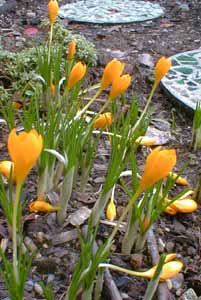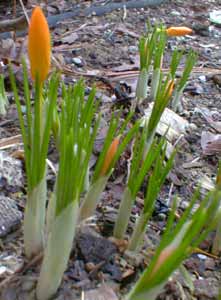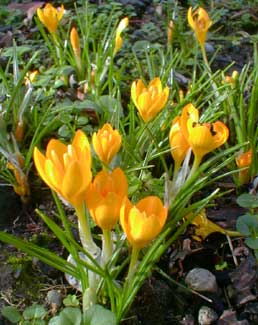 'Golden Bunch'
'Golden Bunch'
Late Winter Crocus;
or, Ankara Crocus
"The golden crocus reaches up
To catch a sunbeam in her cup."
-Walter Crane
(1845-1915)
(1845-1915)
'Golden Bunch' is a pure golden-orange to sun-yellow clone of the botanical Crocus ancyrensis, native of Turkey, Pakistan, & Afghanistan, introduced to gardening in 1943.
 Though so often categorized as an "early spring" bloomer, in reality it is not a spring crocus. It is even more of a winter crocus than the majority of early-blooming species of snow crocuses, many of which get a ahead of spring by blossoming in February, but in our zone 'Golden Bunch' is poking its way out of the ground with colorful buds by mid to late December, & is brightly abloom no later than late January, usually at mid-January.
Though so often categorized as an "early spring" bloomer, in reality it is not a spring crocus. It is even more of a winter crocus than the majority of early-blooming species of snow crocuses, many of which get a ahead of spring by blossoming in February, but in our zone 'Golden Bunch' is poking its way out of the ground with colorful buds by mid to late December, & is brightly abloom no later than late January, usually at mid-January.The yellow bud-portrait below was snapped the third week of January (2004). The flowers are shown beginning to open the first week in February in the first photo, but the third photo shows them already blooming at mid-January (2005) after they had been lifted & moved to a sunnier spot.
The length of time that each crocus species or variety blooms is unusually dependent on weather patterns. If during a crocus's chosen bloom period there are only strongly overcast days, it may scarsely ever be seen fully opened. If it blooms during a stretch of heavy rainfall, many crocuses will be battered to pieces never having shown themselves to best effect. Because 'Golden Bunch' is so extremely early it is more than commonly apt to be ruined by our winter rainstorms. Some years it is truly fine-looking crocus for only about two days before the rain beats it down. Still, it's worth the risk merely to have crocuses appearing serially from as early as possible to as late as possible.
This one blooms either simultaneously with or fast on the heals of other yellow crocuses in our gardens, Crocus koralkowii 'Kiss of Spring' & C. koralkowii 'Mountain's Glory," & immediately before two other crocuses which are in full-colored bud perhaps one week later, these being the Gold Crocus varieties C. chrysanthus 'Gypsy Girl' & C. chrysanthus var fuscotinctus. A very few C. chrysanthus 'Goldilocks' will already have full-opened blossoms as early as the Koralkowi crocuses, but reaches its full glory a week or two behind the other yellows. C. x luteus 'Stellaris' is aglow last of all, which in some years will be later in February, though in 2005 when all the crocuses seemed earlier than their usual average, 'Stellaris' was gorgeously aflower by the last couple days of January.
 It may seem redundant to have so many similar yellows, but having varieties that start a week or two earlier than the average, or a week or two later, insures a maximum length of time with yellow crocuses in the gardens; with our choices we've got one or another yellow present for as long as mid-January to early April.
It may seem redundant to have so many similar yellows, but having varieties that start a week or two earlier than the average, or a week or two later, insures a maximum length of time with yellow crocuses in the gardens; with our choices we've got one or another yellow present for as long as mid-January to early April.It's odd that our autumn-blooming Crocus species tend all to be violet to purple, whereas the very earliest of the early snow-crocuses toward winter's end tend all to be mostly yellows. This may be mere coincidence for the varieties we happen to have chosen, although it is interesting to note that in myths associated with Demeter worship, the first heralds of the return of Persephone were specifically the yellow crocuses.
The name 'Golden Bunch' is often treated as a common name for any strain within this species, rather than as a cultivar name. But if it is truly the specific cultivar, it should be the purest yellow. The species can otherwise be bicolored, either with more white to the petals, or bicolored with faint reddish brown ribs & a dash of magenta deep in the throat. It seems to me these less purely golden strains oughtn't be sold as 'Golden Bunch.' The species is also sometimes given the common name 'Cloth of Gold,' although this name more properly belongs to the closely related C. angustifolius.
A perfect & true 'Golden Bunch' blossom has no markings but is very bright & evenly colored, perhaps at most a little different shade of tangerine deep in the throat. The other yellow species we have tend to have markings on the outer petals at least. C. ancyrensis buds are an orangish-yellow yield-sign color, opening to an only slightly less intense yellow.
It is often a mere two or three inches tall, though ours have reached to five inches at tip of bud, & six inches isn't unlikely. There's a possibility the taller ones have at some point their past hybridized with C. angustifolius or some other yellow crocus. But I think ours got "too tall" & floppy their first year because they weren't getting enough sun so started "reaching." The first photo (early February, 2004) shows their floppiness; that year they only stood erect on the sunniest days. When we transplanted the bulbs in a sunnier garden, they were much smaller & more sturdily upright, as can be seen in the third photo below (mid-January, 2005).
Furthermore the blooms are rarely bigger than two inches wide & often only one-inch wide. But each bulb is multi-flowering, so ten bulbs can be a good start for a naturalizing drift, & will look substantial even for its first year. A single older mature corm that has found its conditions exceedingly favorable has been known to produce a dozen or even two-dozen flowers! Three per corm would be more ordinary, but four to six each wouldn't be unusual.
Not all the blooms open together, which ideally has the effect of extending the overall length of time it blooms. Despite this, alas, they sometimes have only a very brief flowering. Especially if a hard rain batterns them to their side, critters in the soil do away with those petals all too swiftly.
'Golden Bunch' prefers neutral to slightly alkaline soil, but ours have gotten by fine in acidic soil. We initially planted this drift at the foot of a Kiwi Vine, & mixed among them the more wholeheartedly reliable C. chrysanthus 'Blue Pearl,' a snow crocus flowers February & March. Just as 'Golden Bunch' was finishing off, 'Blue Pearl' took over the location, extending the presence of crocuses in that general spot. There is also a large drift of C. tommasinianus 'Whitewell Purple' close by, & these tiny hardy crocuses begin to flower shortly after the 'Blue Pearl.'
This mix seemed a good idea in theory, but C. ancyrensis needed more sun than did the others, so was lifted & moved as soon as it was done blooming. I did know they needed the most sun, but when the bulbs were planted in Autumn the spot by the kiwi vines seemed quite a sunny, but by January the sun was off at another angle so that when this crocus bursts forth, the sun was longer behind a Douglas Fir.
Full sun is best, especially in temperate zones, in order that it can have a hot dry summer dormancy, without which it might not naturalize. So too they may not naturalize without a sufficiently cold winter, as in an unseasonably warm winter they will be lovely midwinter bloomers the first year, but not apt to survive a second year without both a hot summer dormancy & cold winter dormancy.